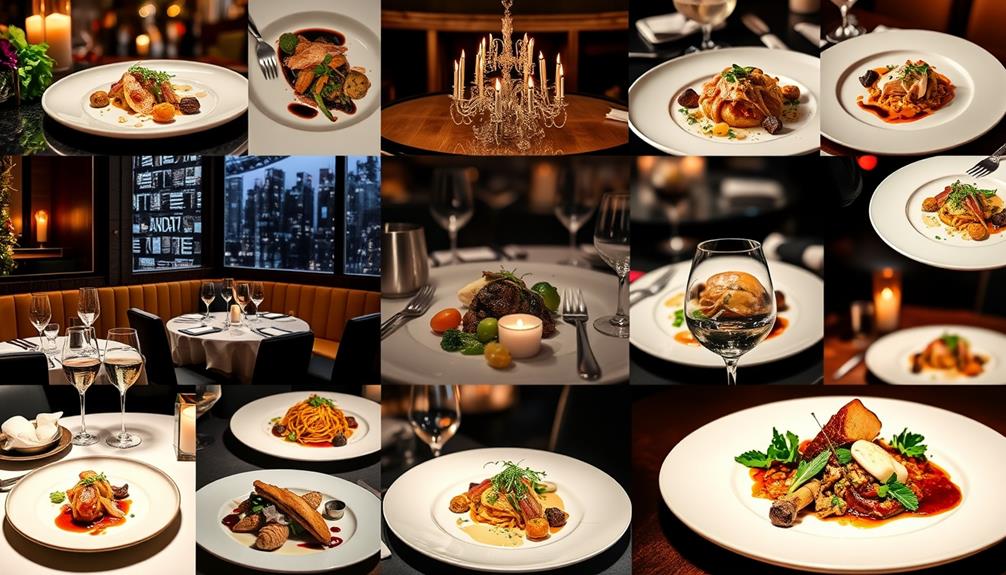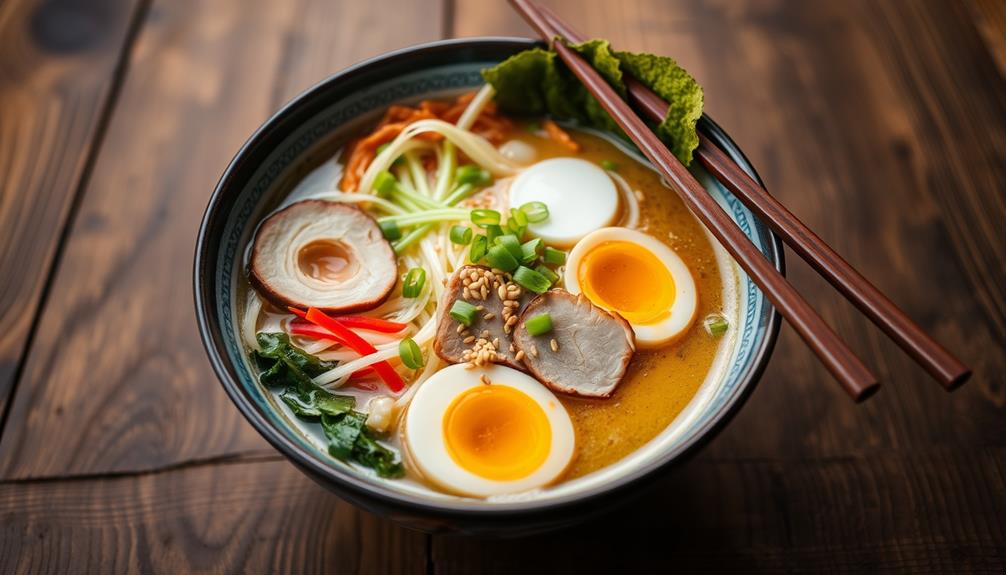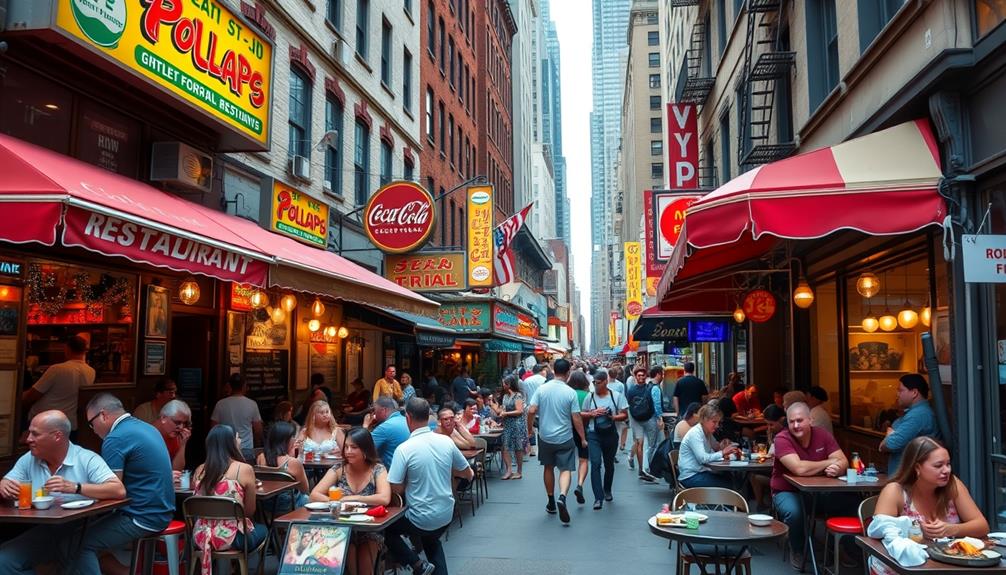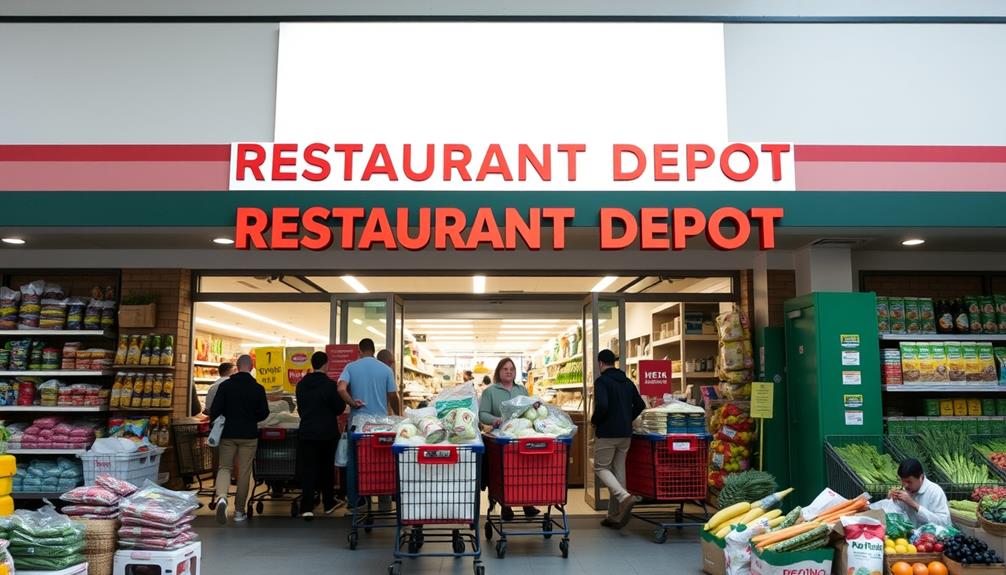Opening a small restaurant usually costs between $50,000 and over $500,000. You'll need to account for initial funding ranging from $20,000 to $250,000. Key expenses include kitchen equipment, furniture, licensing, and permits, which can total $20,000 to $400,000. Monthly operating costs add up too, with rent averaging around $5,000 and utilities between $1,000 and $1,200. Don't forget about marketing and staffing expenses; they're essential for success. It's a hefty investment, but understanding all aspects can make it manageable. There's much more to explore about how to plan effectively for your new venture.
Key Takeaways
- Startup costs for small restaurants typically range from $50,000 to over $500,000, including initial funding and one-time expenses.
- Monthly operating expenses average around $10,000, encompassing rent, utilities, and labor costs.
- Licensing and permits can cost between $2,500 and $200,000, depending on local regulations.
- Kitchen equipment and renovation costs can total $20,000 to $400,000, varying based on size and design.
- Marketing and branding expenses usually account for 3% to 6% of projected sales, impacting overall startup budgets.
Cost Overview for Small Restaurants
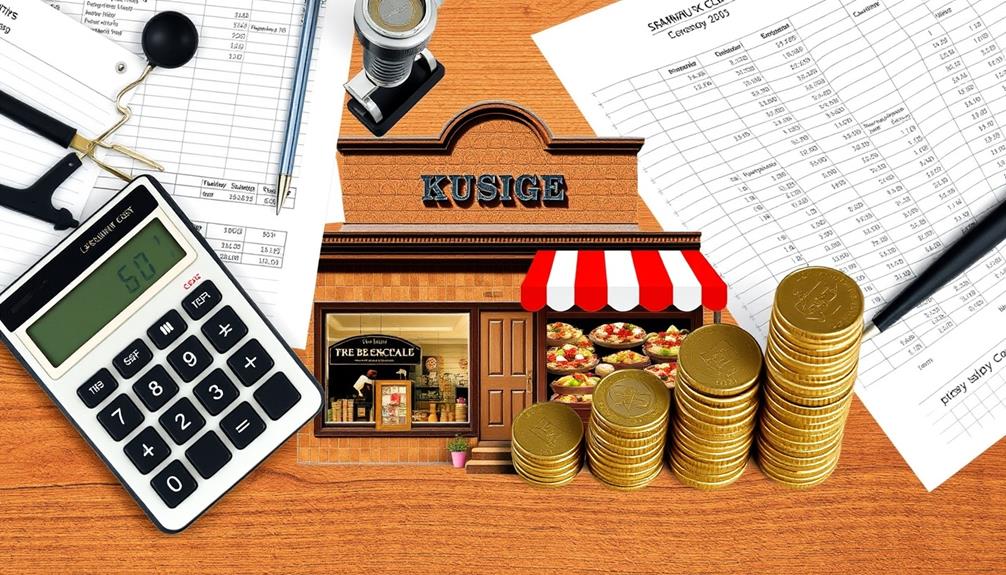
When you're looking to open a small restaurant, it's vital to understand the financial landscape you'll face. The startup costs can vary greatly, ranging from $50,000 to over $500,000. Factors like location, size, and concept heavily influence these figures.
You'll encounter one-time expenses like kitchen equipment, POS systems, and furniture, which can add up to between $20,000 and $400,000. Additionally, having a clear budget that outlines your income and expenses is critical for long-term success.
Once you've opened your doors, you'll need to manage ongoing operating costs. Monthly utility bills typically range from $1,000 to $1,200, depending on your restaurant's size and usage.
Renting a space will also contribute to your monthly expenses, with costs averaging around $5,000, but potentially ranging from $1,000 to over $10,000.
Don't forget about licensing and permits, which can take a considerable bite out of your startup budget. Depending on your local regulations, you might need to allocate anywhere from $2,500 to $200,000 to guarantee compliance.
Understanding these costs upfront will help you create a realistic budget and set your restaurant up for success right from the start.
Startup Cost Breakdown

When you're planning your restaurant, understanding the startup cost breakdown is vital.
You'll need to take into account major expense categories like equipment and labor costs, as well as the necessary licensing and permits.
It's also important to factor in the potential financial implications of running a business, similar to how one might need to navigate the division of assets in a divorce, such as financial implications.
Each of these elements can greatly impact your overall budget, so it's important to plan accordingly.
Major Expense Categories
Opening a small restaurant involves maneuvering a complex landscape of expenses that can considerably impact your startup budget. Understanding major expense categories is key to steering through these costs effectively.
Here's a breakdown to help you visualize:
1. Location Costs: Renting a space typically averages around $5,000 a month. Depending on your choice, this can greatly influence your startup costs.
Additionally, considering the potential financial aid sources for eligible individuals can assist in planning your overall budget, especially if you consider funding options for operational expenses.
2. Labor Costs: Expect labor to account for 25% to 30% of your total operating expenses. Management salaries can range from $40,000 to $70,000 annually, so plan accordingly.
3. Marketing Expenses: To guarantee visibility, set aside 3-6% of your sales for marketing. This can include website development, which can cost between $1,000 and $5,000+.
Equipment and Labor Costs
A small restaurant's success hinges greatly on its equipment and labor costs, which can vary widely based on your specific needs and style.
When it comes to equipment, you might spend between $5,000 and $20,000+ on cooking appliances and another $3,000 to $10,000 on refrigeration units. It's crucial to contemplate investing in multi-functional equipment to save both space and costs, much like the approach taken in mastering the art of bug out bags.
Don't forget about preparation equipment, which usually costs between $1,000 and $5,000, and dishwashing equipment that can range from $2,000 to $10,000. Furniture and seating can add another $5,000 to $20,000 to your startup costs, depending on what aesthetic you choose.
Labor costs are another significant factor in restaurant operating expenses, typically accounting for 25% to 30% of your total budget.
Back-of-house staff labor usually makes up 20% to 25% of total revenue, so be prepared for these ongoing expenses. Additionally, if you're managing the restaurant, your salary will likely fall between $40,000 and $70,000 annually, further impacting your financial planning.
Understanding these costs upfront will help you create a more accurate budget and set your restaurant on the path to success.
Licensing and Permits
Steering through the world of licenses and permits is vital for launching your small restaurant, as these costs can range anywhere from $2,500 to $200,000 based on your restaurant's type and location.
It's important to be aware of potential challenges, such as managing regulatory compliance and understanding the risks and rewards of investments that may arise during your startup phase.
You'll need to account for various fees that can quickly add up, so here's a breakdown of common costs:
- Business License: Typically costs between $75 and $7,000+, depending on your area.
- Food Service License: Expect to pay around $100 to $1,000 to comply with health regulations.
- Liquor Licenses: These can range from $300 to $14,000, heavily influenced by state laws and the type of alcohol service you plan to offer.
In addition to these, don't forget about other important permits like a Certificate of Occupancy and a Food Handling Permit, which may have their own fees.
Key Expenses to Consider
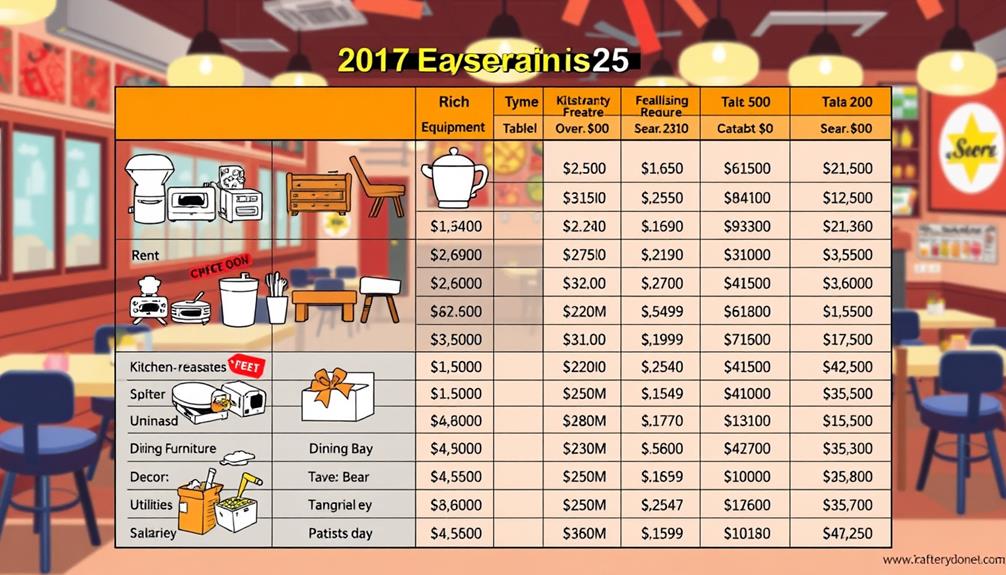
When considering the key expenses for launching a small restaurant, it's important to account for several significant costs that can impact your budget.
Restaurant startup costs can range widely, typically falling between $50,000 to $500,000+, influenced by your location, concept, and amenities. Additionally, understanding the financial environment and regulations that may affect your startup can provide valuable insights into your overall budget. For more information on financial regulations, check out financial policies.
You'll need to factor in vital licenses and permits, which can set you back anywhere from $2,500 to $200,000 depending on your restaurant type and local regulations.
Equipment purchases, especially for your kitchen and bar, average around $115,000, so you'll want to budget accordingly. Labor costs are another major factor, often accounting for 25% to 30% of your operating expenses.
Don't forget about monthly utility expenses, usually between $1,000 and $1,200, with electricity and natural gas being significant contributors.
Finally, marketing costs are critical for drawing customers. These typically represent 3-6% of your sales, with initial branding and promotional efforts costing anywhere from $1,000 to over $5,000 for website development and local advertising.
Location and Rent Factors
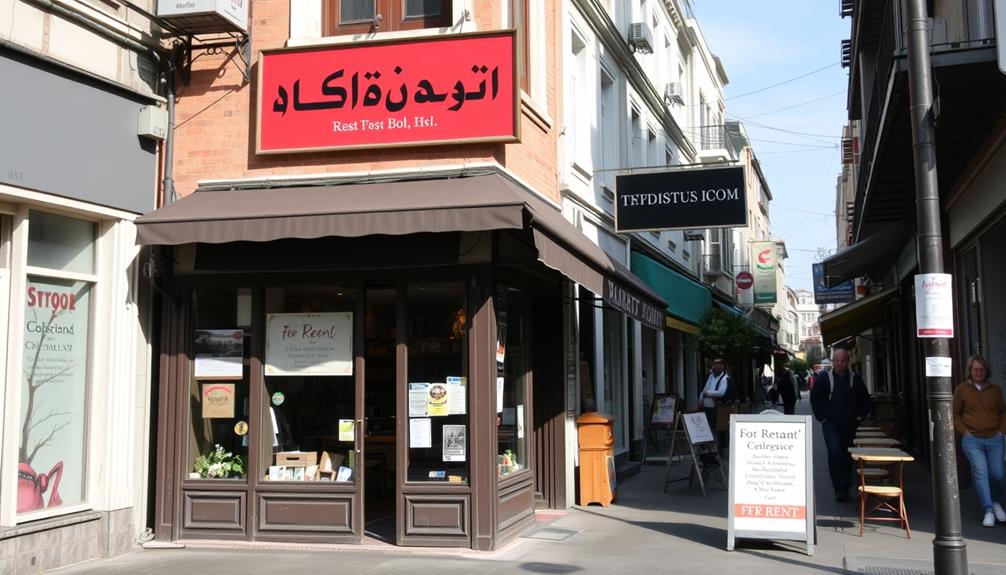
When you're choosing a location for your small restaurant, remember that it can make or break your success.
Rent costs vary widely based on where you set up shop, impacting your overall budget considerably. For instance, areas with high foot traffic may command higher rents but could lead to increased customer volume, similar to how the presence of security systems can deter potential threats and enhance safety.
Understanding these factors is vital as you plan your restaurant's financial future.
Impact of Location Choice
Choosing the right location for your small restaurant is vital, as it directly influences rent costs and overall profitability. The location choice impacts your rental costs greatly, with average monthly rents ranging from $2,000 to $12,000, depending on demand and foot traffic.
Understanding effective preparation can help you choose a location that aligns with your business strategy. Here are three key factors to take into account:
- Space Requirements: Traditional restaurants typically need 1,000 to 2,000 square feet, while ghost kitchens require only 200-300 square feet, drastically reducing rent expenses.
- Traffic Patterns: A location in a high-traffic area might command higher rental costs but can lead to increased customer visits, enhancing your revenue.
- Cost Proportion: Rent can constitute 5% to 10% of your monthly operating costs, meaning that a strategic location choice can greatly impact your financial sustainability.
Ultimately, balancing rental costs and location advantages will be vital for your restaurant's success.
Spend time researching various neighborhoods and analyzing foot traffic patterns to guarantee your investment aligns with your business goals.
Rent Cost Variability
How much you pay in rent can vary drastically based on several essential factors.
The location of your restaurant plays a vital role in determining rent cost variability. For instance, areas in urban settings often have higher rents than suburban or rural locations. Your commercial space's size is also important; renting a larger space typically leads to higher monthly costs.
Additionally, choosing a location that offers unique experiences, much like the diverse tent camping locations in New England, can attract more customers and potentially justify higher rent. On average, you might find median rent hovering around $5,000 per month, which usually constitutes about 5% to 10% of your monthly operating expenses.
If you're considering a ghost kitchen, you could greatly reduce your rent expenses. These kitchens need only about 200-300 square feet, which can be a cost-effective option for new restaurant owners.
When leasing a property, expect to pay around $159 per square foot, whereas purchasing can set you back about $178 per square foot.
Ultimately, when planning your budget, keep these rent factors in mind. They can make a big difference in your overall financial strategy and success in the restaurant business.
Equipment and Renovation Costs
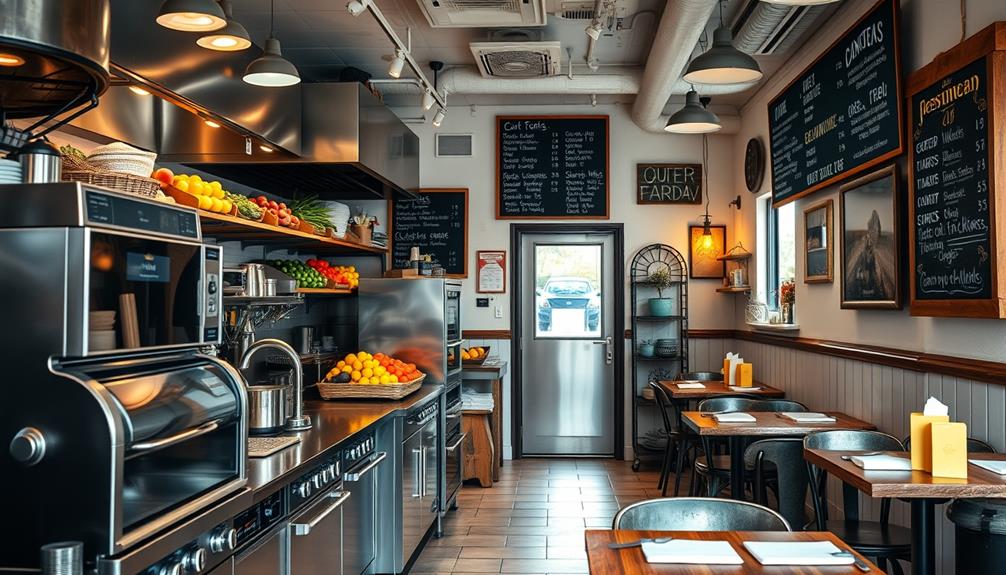
Opening a small restaurant involves substantial investment in equipment and renovations that can greatly influence your startup budget. The costs can vary widely based on your choices and the condition of your space. Here are some essential expenses to keep in mind:
1. Kitchen Equipment: Expect to spend between $20,000 and $400,000 on essential cooking appliances, refrigeration units, and more.
Cooking equipment alone can range from $5,000 to $20,000+, while refrigeration may cost between $3,000 and $10,000. Choosing energy-efficient appliances can help reduce overall energy consumption, which is vital for managing operational costs in the long run, especially when taking into account energy-efficient appliances.
2. Renovation Costs: Depending on how much you need to change the layout and decor, renovation expenses can greatly impact your budget.
Building from scratch can reach up to $800 per square foot, while renovating an existing location often proves more economical.
3. Furniture and Seating: Don't forget about the dining area!
Furniture and seating expenses can total between $5,000 and $20,000, depending on the style and number of seats you require.
Licensing and Permits

When you're opening a small restaurant, securing the right licenses and permits is essential.
You'll need to navigate various compliance and regulatory costs, which can quickly add up.
Understanding these requirements upfront can help you budget effectively and avoid costly delays.
Required Licenses and Permits
Securing the necessary licenses and permits is vital for legally operating your small restaurant. Without these, you could face fines or even be forced to shut down.
Here's what you'll need to take into account:
- Business License: This is your first step to legally establishing your restaurant.
- Food Service License: Required to guarantee you meet food safety standards.
- Health Department Permit: Important for compliance with local health regulations, often costing between $100 and $1,000.
In addition to these, if you're planning to serve alcohol, a liquor license is essential, and costs can vary greatly, ranging from $300 to $14,000 based on state regulations.
You may also need additional permits like a Certificate of Occupancy and a Food Handling Permit for your staff.
Compliance and Regulatory Costs
Steering through compliance and regulatory costs is an essential step in launching your small restaurant. The costs associated with obtaining restaurant licenses and permits can vary greatly, typically ranging from $2,500 to $200,000. Factors like your location and the type of restaurant you're opening play a significant role in these expenses.
A business license usually costs between $75 and $7,000+, while a food-handling service license can set you back anywhere from $100 to $1,000. If you plan to serve alcohol, be prepared for liquor license costs that can run from $300 to a staggering $14,000, depending on state regulations and the alcohol types you intend to offer.
In addition to these licenses, you'll need various permits, such as an Employer Identification Number (EIN), a Certificate of Occupancy, and both a Food Service License and Food Handling Permit for your staff.
Maneuvering through these compliance and regulatory costs can be complex, often requiring several months of preparation before you can open your doors. Ensuring you have all necessary licenses and permits is critical for a successful launch.
Marketing and Branding Expenses
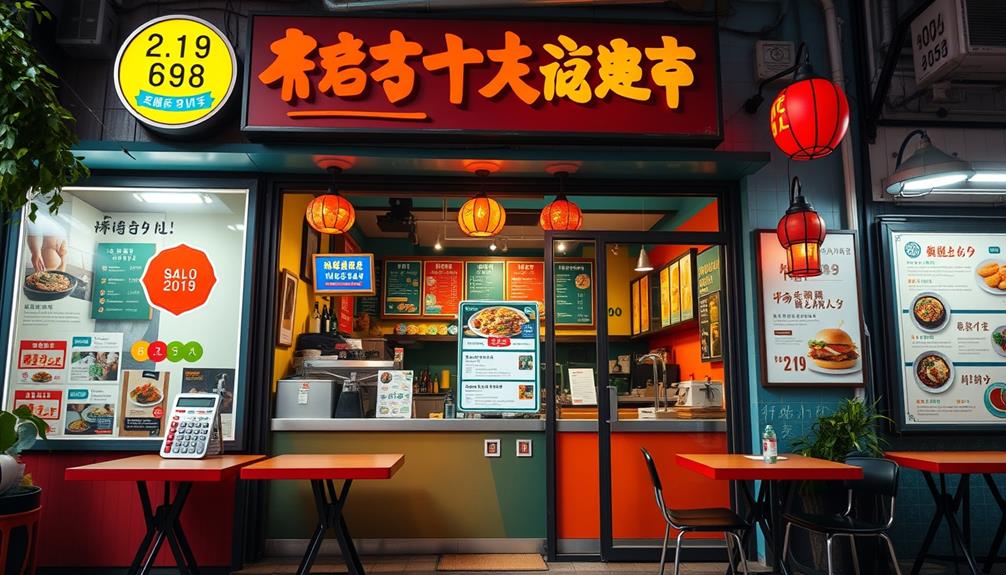
Effective marketing and branding expenses are vital for the success of your small restaurant, typically ranging from 3% to 6% of your projected sales. To guarantee your restaurant stands out, it's important to allocate your budget wisely.
Here are three key areas to focus on:
- Website Development: Expect to spend between $1,000 and $5,000, depending on the features and complexity you need for your online presence.
- Local Advertisement: Your budget will vary based on competition and target demographics, so thorough market research is vital for effective spending.
- Branding and Design: Establishing a strong identity that resonates with customers can require $1,000 to $5,000 or more.
While social media can be started at little to no cost, effective marketing campaigns often need additional funds for sponsored posts and management tools.
By investing in these marketing and branding efforts, you'll create a solid foundation for your restaurant's visibility and customer engagement.
Staffing and Labor Costs

How do you guarantee that your staffing and labor costs remain manageable while still providing excellent service? First, understand that labor costs typically range from 25% to 30% of your total operating expenses. That means you need to budget wisely, especially since quick-service establishments tend to have lower labor costs.
When you're hiring, consider the average salaries for management positions, which can range from $40,000 to $70,000 annually. Front-of-house staff wages vary from minimum wage to over $15 per hour, so it's vital to offer competitive pay to attract talent, especially since 7 in 10 restaurants report difficulty hiring sufficient staff.
Back-of-house labor costs, including chefs and cooks, usually account for 20% to 25% of your total revenue. Efficient staffing is essential for keeping these costs in check.
Also, don't forget that employee benefits and payroll taxes notably add to your labor expenses, so factor these into your budget. By balancing competitive wages with careful staffing, you can maintain a sustainable labor cost while ensuring your restaurant delivers the excellent service that keeps customers coming back.
Financial Planning Strategies
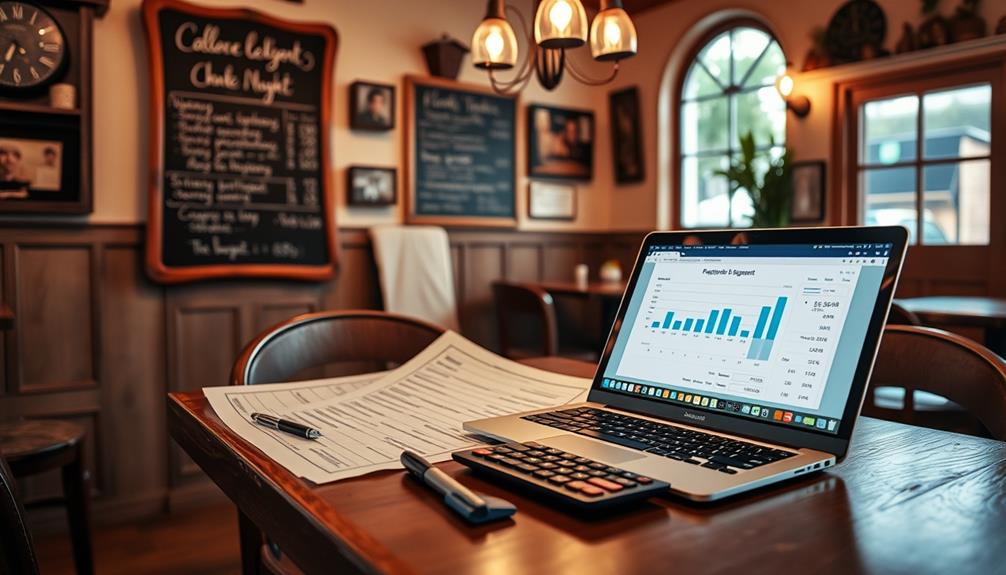
When it comes to opening a small restaurant, solid financial planning is key to your success.
You'll need to carefully assess the financial costs of opening, which can range from $20,000 to $250,000 for startup expenses. To guarantee you're on the right track, focus on these essential strategies:
- Create a detailed budget and business plan: Outline your vision while budgeting for ongoing costs like rent, which can be $1,000 to $10,000 monthly, and utilities, averaging $1,000 to $1,200.
- Allocate funds for marketing: Set aside 3-6% of projected sales to effectively promote your restaurant and attract customers.
- Establish a contingency fund: Prepare for unexpected costs that often arise during the opening phase, assuring your financial stability.
Funding Options for New Restaurants
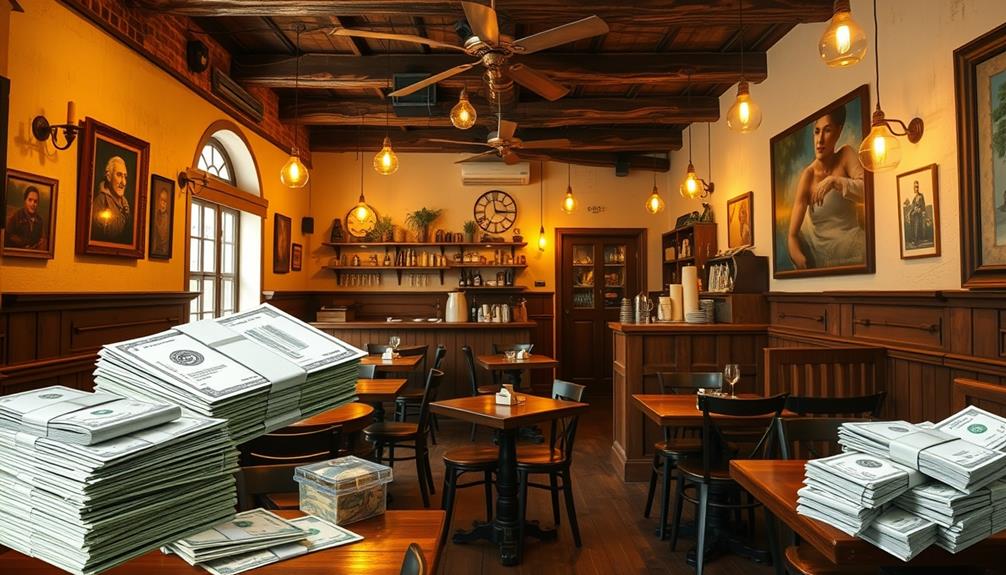
Securing funding for your new restaurant is an essential step in turning your vision into reality. Initial funding typically ranges from $20,000 to $250,000, and having a financial cushion for the first six months of operations is critical.
You've got several funding options to evaluate. Bank loans are a common choice, but they often require a solid business plan and collateral. Be prepared to demonstrate how your restaurant will succeed to secure these funds.
If traditional financing isn't an option, you can look for investors willing to provide capital in exchange for equity or a share of profits, which can greatly lighten your financial burden.
Another innovative way to gather funds is through crowdfunding platforms, where you can attract small investments from a large number of people. This method can help you raise funds without incurring substantial debt.
Additionally, explore grants and local funding programs, especially those supporting community development or specific market needs—these can provide essential financial backing.
Frequently Asked Questions
Is 50K Enough to Start a Restaurant?
You can start a small restaurant with $50,000, but it'll be tight. Focus on a takeout model or shared kitchen to manage costs effectively. Remember to set aside funds for unexpected expenses along the way.
Do Small Restaurants Make a Lot of Money?
Small restaurants can be profitable, but it varies. You might earn around $5,000 monthly, depending on your restaurant's performance. With time and loyal customers, your profits could increase considerably with proper planning and execution.
How Much Money Should You Have to Open a Small Restaurant?
To open a small restaurant, you should have at least $50,000 to $250,000 saved. This amount covers essential startup costs, equipment, and six months of operational expenses, ensuring you start on solid ground. Starting a restaurant business is a significant financial investment, and it’s essential to have a solid financial plan in place before taking the leap. It’s also important to consider factors such as location, target audience, and menu offerings when calculating startup costs. With careful planning and a realistic budget, starting a restaurant business can be a rewarding and profitable venture.
What Is the Startup Cost for a Small Restaurant?
When considering startup costs for a small restaurant, you'll typically face expenses ranging from $50,000 to $500,000. Factors like location, concept, and size will greatly influence your total investment and ongoing monthly costs.
Conclusion
Opening a small restaurant can be a thrilling venture, but it comes with its challenges. Did you know that nearly 60% of new restaurants fail within their first year? By carefully planning your startup costs and understanding your key expenses, you can set your eatery up for success. Remember, your passion for food and community can turn those statistics around. With the right strategies and funding, you can create a place where people gather and memories are made.

